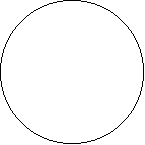Phases of the Moon:
How to Keep a Diary
This document will be modified as time goes on and is intended to get you started; it's really more appropriate for middle school and older students. A modified version of this page for younger Scouts is also available. If you have questions, please email Mitzi Adams at mitzi.adams@nasa.gov.Question: What am I supposed to do?
Answer: Each time that you find the moon, make a sketch using circles on the next page as a template, showing the phase of the moon. Be sure to do this as accurately as possible, especially noting the directions (i.e., is the Moon in the southeast part of the sky?). Also, measure and note the angular size of the moon and note the time of day.
Question: How do I measure angular sizes in the sky?
Answer: You can use your hand held at arms length to measure angles in the sky. Your finger (any one) is roughly 1o wide. If you clinch your fist, it is about 10o wide. If you spread your fingers apart, from the tip of your little finger to the tip of your thumb is around 20o
Question: When do I need to start on the activity?
Answer: Today.
Question: How often do I need to make these measurements?
Answer: You should make observations every day that you have a clear sky until you've seen one complete cycle of Moon phases. For example, if your first observation was a full moon, your should observe until you see another full moon.
Question: Why is it important to do this?
Answer: Scientific inquiry begins with observations. From observations, you can see patterns and begin to understand the nature of things. From observations associated with this particular moon phases activity, you will begin to understand why the moon goes through phases.
Question: When and where will I be able to find the moon?
Answer: Here is a table of moon phases. If you are looking for the full moon,
the best time to find the moon on that day is just at sunset in
the eastern sky. After that, you'll have to wait later and later
to see the moon rise.
| New Moon | First Quarter | Full Moon | Third Quarter |
| Nov 6 | Nov 13 | Nov 21 | Nov 28 |
| Dec 5 | Dec 13 | Dec 21 | Dec 28 |
Answer the following questions:
1. What do you think the phase of the moon will be on or about October 19?
2. What time do you think the moon will rise?
Note the following for :
Date Moon Rise Moon Set
Full Moon _____ pm _____ am
First Quarter _____ am _____ pm
Interpreting your moon log observations.
This part of the activity is designed to lead you to a thorough understanding of why the moon goes through phases. You will be using the observations of the moon from the last four weeks as you do this activity. Use your observations from the last two weeks to summarize the pattern of lunar phases:
A) Describe how the amount of the moon that appears to be illuminated has changed in the last few weeks.
B) What does the term "waxing" mean? How does this definition relate to the position of the Moon with respect to the Sun?
C) Use your data for your first and last observations of the moon to fill in the following table:
|
Date:
___________
Time: ___________ Angular size of Moon: ___________ Direction of Moon from Sun: (E or W)
|
Date:
____________
Time: ____________ Angular size of Moon: ___________ Direction of Moon from Sun: (E or W)
|
Last revised 2002 October 6 - M. Adams
|
||||||||||||||||||||


